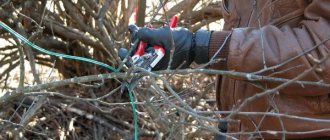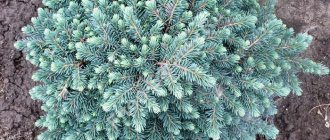4517
Some ornamental shrubs lend themselves well to formative pruning. Chubushnik is no exception to this list. Removing damaged and old shoots is necessary not only to maintain decorativeness, but also for the active growth of the shrub. By practicing regular pruning of mock orange in the spring and after flowering in the summer, you can achieve amazing results. Autumn sanitary procedures are also necessary to free the plant from weak and damaged branches.
Mock orange, derain, roses
When can you reproduce?
Before answering the question of how to propagate mock orange, you should first find out when and at what stage of its development actions are carried out aimed at obtaining material for further cultivation:
- Both spring and autumn are suitable for planting mock orange seeds. The most favorable months are April and November;
- Woody shoots for preparing cuttings are cut in the fall immediately after the leaves fall to avoid the appearance of young shoots at this time. In spring they are planted at the moment the flower buds swell;
Mock orange bushes are growing strongly
- propagation of mock orange by cuttings in the summer is carried out exclusively by green shoots, which are taken during flowering;
- The method of propagating mock orange by layering is appropriate in April-May. The next stage of breeding “garden jasmine” is separating the rooted shoots from the mother bush. Replant to a permanent place either in the fall or next spring;
- The method of dividing the bush is used in the spring - from March to April, or in the fall - from mid-October to early November.
Note! In addition to the fact that the plant is rarely affected by various diseases and is generally undemanding in terms of care, when it comes to how to breed mock orange, you can use several effective methods at once.
Rules for planting cuttings in the ground
If you plan to plant a rooted cutting directly into the ground, and not grow it in a pot at home, it must be prepared. A week before planting, you need to start hardening the young plant, then it will not experience shock and will better adapt to the new place.
The soil must be prepared in advance. The soil is dug up, fertilizers are applied and watered just before planting the cuttings.
After the procedure is completed, the plant is hilled up and special attention is paid to it in the first month. The seedling must be watered regularly and the soil around it must be loosened.
The next year, the top of the bush is trimmed so that it grows with a spreading crown and is lush.
Soil preparation
If an adult bush has grown too much, it can be divided into several parts. How to plant jasmine by dividing the bush correctly? It is better to start this process in spring or autumn. A day before the jasmine bush is dug up, it is watered abundantly. After being removed from the ground, the plant is divided into several parts, each of which must have roots.
Roots that are too long are shortened, and the length of the shoots is also slightly reduced. When planting, jasmine is buried to the lower buds. The land must be pre-fertilized and disinfected. After planting, the plants need to be watered. The rooting process will take 3-5 weeks in this case. The crop can also be propagated by layering.
You should be puzzled by the question of how to propagate jasmine by cuttings if there is a lot of material left after pruning, or there is not yet an adult bush on the site that can be divided. This method can also be used when several branches for planting were received from neighbors in the country. Propagation by cuttings will require a certain amount of time, but as a result the gardener will receive a large number of new plants that are well adapted to growing in his area.
vote
Article Rating
Propagation by seeds
How to feed gladioli in spring and summer
They begin to collect seeds at the end of summer, when the mock orange flowers have faded and its seed pods have ripened. This breeding method is suitable only for the species forms of this ornamental shrub. As for plant hybrids, mock orange is propagated vegetatively.
Mock orange seedlings from seeds
How to propagate mock orange with seeds? This can be done in two ways, which depend on the time of year.
- Planting before winter. Pre-prepare the bed and make furrows. Then they are sown with seeds and covered with compost. Arches are installed over the garden bed and covered with spruce branches for the winter. After the snow has completely melted, the spruce branches are removed and instead covered with non-woven material to shade the hatching seedlings.
- Spring planting. This method allows you to grow seedlings at home. Seed collected in the fall should be used, but the storage period should not exceed more than 1 year. In addition, the storage conditions must be met: the seeds are stored in the refrigerator in a sealed bag. In spring they are planted in cups. In June, grown and strengthened seedlings are transplanted into the ground.
Important! Since it is not possible to propagate hybrid and garden varieties of mock orange so that all varietal characteristics are preserved, seeds can only be used from the species forms of “garden jasmine”.
Mock orange in the hedge
Garden jasmine grows well in fertile and fairly moist (but not waterlogged) soils, where the bush develops very quickly and blooms wonderfully. But the most hardy mock orange species can live on any, even poor soils and in unfavorable environmental conditions.
The average height of a garden jasmine bush is 2 meters, but in favorable conditions it can grow up to 3 meters, and tall, powerful varieties - up to 4 meters.
Due to the density of the tall bush, mock orange is successfully used for making hedges. In this case, it is important to mass propagate the desired species or variety of mock orange to obtain a large amount of planting material.
The hardiest types of garden jasmine, as well as their beautifully flowering and decorative-leaved hybrids, forms and varieties, are most often used in hedges. Most often these are mock oranges (Philadelphus): coronary (coronarius) and large-flowered (grandiflorus), etc.
Cuttings
When to plant hazel grouse: planting in autumn or spring
Cuttings of mock orange in summer or winter remain the most popular method of propagating shrubs for many gardeners. It allows you to grow mock orange that has all the varietal characteristics characteristic of the parent bush.
How to take mock orange cuttings in summer
How does mock orange jasmine propagate from green cuttings? To do this, you must first of all comply with the conditions stated below:
- for work you must use only a sharp knife;
- green shoots are used with part of the annual branch, otherwise it is also called the heel;
- the harvested material must be 5 cm long with two leaves;
- During the cutting process, the lower leaves are removed, and the upper ones are shortened by about a third.
Cuttings of green shoots
Sequence of how to propagate mock orange by cuttings in the summer:
- In loose, moist soil that contains sand, make a hole 1 cm deep.
- The prepared cutting is placed in this hole, and the substrate around it is lightly pressed.
- Then the shoot is sprayed and covered, for example, with a cut plastic container.
- Further care of the twig consists of regular ventilation and spraying.
In October, the seedlings are transplanted to a permanent location. Choose a sunny area for this.
The process of cuttings from lignified shoots
Material for this type of cultivation of ornamental shrubs is harvested in the fall. To do this, lignified annual branches are cut off, wrapped in film, and put in a cool place - a cellar or refrigerator.
Cuttings of woody shoots
Further steps on how to root mock orange:
- In March, the prepared material is obtained, from which shoots up to 20 cm long are cut. Each cutting must have at least 4 pairs of buds.
- The upper cut is made above the kidney at a distance of 1 cm at a right angle. The lower cut is made maintaining the same distance from the pair of buds, but at an angle of 45°.
- After the manipulations, the finished cutting is placed for a day in a solution used to stimulate root formation.
- After this time, the shoots are planted in moist, loose soil so that the cuttings are slightly inclined.
- To make the plant take root better, it is sprayed and covered with a plastic bottle, cut so that the neck is on top.
Note! Cuttings need to be periodically sprayed and watered. It is important to maintain a moist environment and to ventilate the plant from time to time.
Complete rooting of mock orange will occur in 5 weeks. At the end of May, the established shoots are transplanted to a permanent place for their further growth.
What is needed to propagate mock orange?
To root them you will need: sand, peat, drainage material (for example, expanded clay), a container and a cap or polyethylene for covering.
Place a layer of drainage on the bottom of the pot, and a mixture of peat and sand in equal proportions on top. It is better to mix them already slightly moistened.
Pour clean sand on top with a 2-3 cm layer and cover with a fungicide solution.
On the cuttings we cut off the lower leaves and inflorescences.
Soak mock orange cuttings in a stimulant solution (Epin) for 12 hours (not necessary, but recommended).
Dip a cut of a garden jasmine cutting into root formation stimulator powder.
We plant in the prepared container at an angle of 30-40°. The petioles of the lower leaves should not be immersed in the sand!
Reproduction by layering
How to propagate rhododendron: cuttings, in the country
One of the easy ways to breed mock orange is to propagate it by layering. The best time for this is April-May, when the snow cover is all gone. The work is being carried out according to the following plan:
- Take the lower branch and bend it carefully to the soil.
- Then they make a mark where the shoot came into contact with the ground.
- Next, cut off a part of the bark at least 1 cm wide at the mark.
- Fix the branch with a wire, pressing it to the ground.
- The cut is sprinkled with additional soil, then the soil is pressed down and watered thoroughly.
Mock orange layering scheme
Until autumn, the layering should be checked occasionally and sprinkled with earth. As an alternative, mulch is used. During particularly dry seasons, the cutting area must be watered frequently.
For your information! With the onset of autumn, you can begin replanting, having first separated the mock orange layering from the parent bush. But this process can be done next spring.
Reproduction in autumn
Mock orange is also good for propagation in the autumn. In this case, the branches are cut about 15 cm in October and planted in the garden bed. They are planted so that only 1-3 buds remain above the ground. In winter, pets are mulched with peat. You can use sawdust or humus and cover it from frost. Rooting of branches should take place at one hundred percent humidity; there should be no stagnation of water. That is why it is necessary to arrange good drainage at the place where pets are planted. Future plants should be sprayed at least twice a day in the first 7 days, especially in hot weather. The roots appear in about three weeks, after which the new plant is sprayed once a day.
Dividing the bush
This method of propagating mock orange is suitable if the bush has grown too large. Then it is dug up and divided into 3-4 parts. In this case, the following conditions must be observed:
- each part must have a sufficient number of healthy roots;
- old damaged roots are cut off, excess shoots are also removed;
- It is advisable to replant the bush immediately on the day of digging it up to avoid drying out of the rhizome;
- If, however, there is no opportunity or time to replant the mock orange on the same day, then its roots should be sprinkled with earth and work continued the next day.
Dividing an ornamental shrub into parts
It is important to start propagation by dividing the bush within the prescribed period. In the spring, it is better to divide when the leaves of the bush have not yet blossomed, in the fall - as soon as the leaves fall.
Note! The place where the plant is transplanted must be fertilized. It is also worth disinfecting the soil - treating it with a solution of potassium permanganate.
Care after breeding
Young shoots and seedlings are especially demanding for further care:
- Watering should be done regularly. Due to drying out of the soil, the plant does not take root well and may even die;
- Immediately after watering, the soil should be loosened well. It is necessary to constantly check for weeds;
- It’s better to mulch the area around the bush so that weeds don’t break through and the soil stays moist longer;
- the use of complex fertilizers promotes better growth of new shoots. With the onset of spring, you can add potassium and phosphorus for abundant flowering of mock orange, which occurs very early. Also, fertilizing in the form of nitrogenous fertilizers will not be superfluous;
- After the mock orange has faded, it should be pruned to form a crown. Faded inflorescences must be removed immediately if you do not plan to collect seeds, otherwise the bush will spend a lot of effort on their ripening.
Young rooted mock orange bush
Important! Young bushes that are in the process of rooting should be covered for the winter. To do this, a frame is made of arcs or wooden blocks around the plant. Spruce branches are placed on top and, if necessary, everything is covered with film. In March, the spruce branches and film are removed, the bushes are treated with fungicides and insecticides so that the young shoots are not affected by fungal diseases.
The above methods of breeding mock orange allow you to obtain high-quality material for planting. With proper care and compliance with all growing conditions, mock orange will take root and after a while will begin to delight with abundant flowering.
How to propagate garden jasmine
The easiest way to propagate mock orange, which is most liked by many gardeners.
- You just need to carefully dig up the basal shoots with roots and plant them on the school. When digging, try not to damage the root system.
- After 1-2 years, the young plant can be transplanted to a permanent location.
The optimal time is early spring or September - early October.
data-ad-format=»auto»{amp}gt;
If you do not remove the faded inflorescences in the summer, then fruits (pods) with seeds are formed that can be collected and sown. It is better to sow seeds in mid-November or early to mid-April.
Sowing seeds in autumn
Sowing seeds in spring
2nd option for spring sowing
If there are only a few seeds, they can be sown at home (as seedlings) in February, and the grown seedlings can be planted in a greenhouse in May.
The greenhouse is covered with film and shaded with branches, a box or thin fabric (mesh). Seedlings are regularly sprayed to maintain high air humidity.











